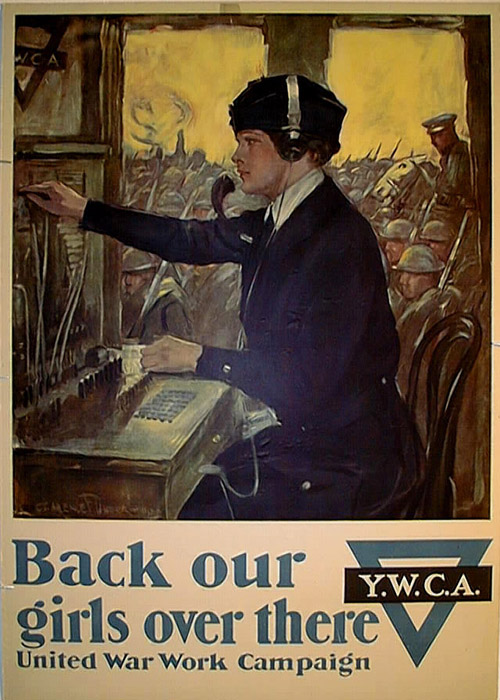
|
|
| This poster was distributed and printed by the Y.W.C.A., the Young
Women's Christian Association, to target primarily young middle-class Christian
women during World War I in the United States. The main goal of the
Y.W.C.A. during wartime was to raise funds for the American Red Cross.
(1) The text of this poster states, "Back our Girls Over There,"
which implies that women should join the workforce in the U.S. to support
the women working for the American Red Cross overseas. However, when
studying the poster, one can see that the text contradicts the images portrayed
by the poster. The figure of a working female surrounding by a background
of male soldiers depicts women supporting male soldiers, rather than working
women overseas.
The main figure in the poster, the working female, is portrayed in a dark-colored uniform which "symbolizes [women's] move out of a state of restrictive femininity and into the men's world of work." (2) Thus, she is upsetting the notion of separate spheres. On the other hand, this symbolism strengthens the ideology of the separation of spheres that was dominant during that period. As the woman is found inside in accord with the ideology of separate spheres, this poster "depicts private space as feminine and public space as masculine." (3) This separation of the women's world from that of males is supported by the window, which separates the dark, interior woman's world from the bright, yellow, exterior male world. The male soldiers in the background are drawn with sharp, straight lines. Thus, men are depicted as active and disciplined while the women are still portrayed as soft and gentle by the use of curved, rounded lines. (4) The main message targets white middle-class women to join the workforce
to support fighting men overseas. The message suggests women should
obtain positions as operators, secretaries, and other jobs previously dominated
by males who are now fighting for them and their country. This transition
of women from the private to the public sphere needs to occur in order
for the United States to continue producing resources for the war and the
economy. In addition, the poster implies more indirectly the need
for men to enlist in the army to show their support for the war effort
and fight for the women back home who are working to support the nation
economically during wartime. The poster's images work well in influencing
both men and women to do their part for the country in a time of need.
This influence not only appealed to patriotism but affected both men and
women psychologically by inducing images of the ideal male and female during
that time period.
1. Berkeley University Y.W.C.A., "Y.W.C.A. at Berkeley University,"
[http://server.Berkeley.edu/ywca/Mission.html],
April 1998.
|